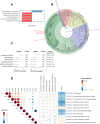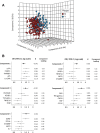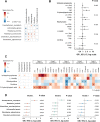Gut microbiota, circulating inflammatory markers and metabolites, and carotid artery atherosclerosis in HIV infection
- PMID: 37237391
- PMCID: PMC10224225
- DOI: 10.1186/s40168-023-01566-2
Gut microbiota, circulating inflammatory markers and metabolites, and carotid artery atherosclerosis in HIV infection
Abstract
Background: Alterations in gut microbiota have been implicated in HIV infection and cardiovascular disease. However, how gut microbial alterations relate to host inflammation and metabolite profiles, and their relationships with atherosclerosis, have not been well-studied, especially in the context of HIV infection. Here, we examined associations of gut microbial species and functional components measured by shotgun metagenomics with carotid artery plaque assessed by B-mode carotid artery ultrasound in 320 women with or at high risk of HIV (65% HIV +) from the Women's Interagency HIV Study. We further integrated plaque-associated microbial features with serum proteomics (74 inflammatory markers measured by the proximity extension assay) and plasma metabolomics (378 metabolites measured by liquid chromatography tandem mass spectrometry) in relation to carotid artery plaque in up to 433 women.
Results: Fusobacterium nucleatum, a potentially pathogenic bacteria, was positively associated with carotid artery plaque, while five microbial species (Roseburia hominis, Roseburia inulinivorans, Johnsonella ignava, Odoribacter splanchnicus, Clostridium saccharolyticum) were inversely associated with plaque. Results were consistent between women with and without HIV. Fusobacterium nucleatum was positively associated with several serum proteomic inflammatory markers (e.g., CXCL9), and the other plaque-related species were inversely associated with proteomic inflammatory markers (e.g., CX3CL1). These microbial-associated proteomic inflammatory markers were also positively associated with plaque. Associations between bacterial species (especially Fusobacterium nucleatum) and plaque were attenuated after further adjustment for proteomic inflammatory markers. Plaque-associated species were correlated with several plasma metabolites, including the microbial metabolite imidazole-propionate (ImP), which was positively associated with plaque and several pro-inflammatory markers. Further analysis identified additional bacterial species and bacterial hutH gene (encoding enzyme histidine ammonia-lyase in ImP production) associated with plasma ImP levels. A gut microbiota score based on these ImP-associated species was positively associated with plaque and several pro-inflammatory markers.
Conclusion: Among women living with or at risk of HIV, we identified several gut bacterial species and a microbial metabolite ImP associated with carotid artery atherosclerosis, which might be related to host immune activation and inflammation. Video Abstract.
Keywords: Atherosclerosis; Gut microbiota; HIV infection; Inflammatory markers; Metabolomics.
© 2023. The Author(s).
Conflict of interest statement
The authors declare no competing interests.
Figures





References
Publication types
MeSH terms
Substances
Grants and funding
- P30 MH116867/MH/NIMH NIH HHS/United States
- P30 DK040561/DK/NIDDK NIH HHS/United States
- U01 HL146245/HL/NHLBI NIH HHS/United States
- U01 HL146205/HL/NHLBI NIH HHS/United States
- R01 HL126543/HL/NHLBI NIH HHS/United States
- R01 MD011389/MD/NIMHD NIH HHS/United States
- P30 AI124414/AI/NIAID NIH HHS/United States
- U01 HL146241/HL/NHLBI NIH HHS/United States
- U01 HL146208/HL/NHLBI NIH HHS/United States
- R01HL140976/HL/NHLBI NIH HHS/United States
- R01 HL132794/HL/NHLBI NIH HHS/United States
- P30 AI050410/AI/NIAID NIH HHS/United States
- U01 HL146194/HL/NHLBI NIH HHS/United States
- UL1 TR001881/TR/NCATS NIH HHS/United States
- K01 HL137557/HL/NHLBI NIH HHS/United States
- UL1 TR003098/TR/NCATS NIH HHS/United States
- P30 AI073961/AI/NIAID NIH HHS/United States
- P30 AI027767/AI/NIAID NIH HHS/United States
- U01 HL146333/HL/NHLBI NIH HHS/United States
- R01 HL095140/HL/NHLBI NIH HHS/United States
- U01 HL146240/HL/NHLBI NIH HHS/United States
- R01 HL083760/HL/NHLBI NIH HHS/United States
- U01 HL146242/HL/NHLBI NIH HHS/United States
- U01 HL146192/HL/NHLBI NIH HHS/United States
- R01 HL140976/HL/NHLBI NIH HHS/United States
- U01 HL146204/HL/NHLBI NIH HHS/United States
- U01 HL146193/HL/NHLBI NIH HHS/United States
- U01 HL146202/HL/NHLBI NIH HHS/United States
- K01 HL160146/HL/NHLBI NIH HHS/United States
- P30 AI050409/AI/NIAID NIH HHS/United States
- U01 HL146201/HL/NHLBI NIH HHS/United States
- U01 HL146203/HL/NHLBI NIH HHS/United States
- P30 CA013330/CA/NCI NIH HHS/United States
- UL1 TR000004/TR/NCATS NIH HHS/United States
- K01 HL129892/HL/NHLBI NIH HHS/United States
- U01 AI035004/AI/NIAID NIH HHS/United States
LinkOut - more resources
Full Text Sources
Other Literature Sources
Medical
Research Materials
Miscellaneous

